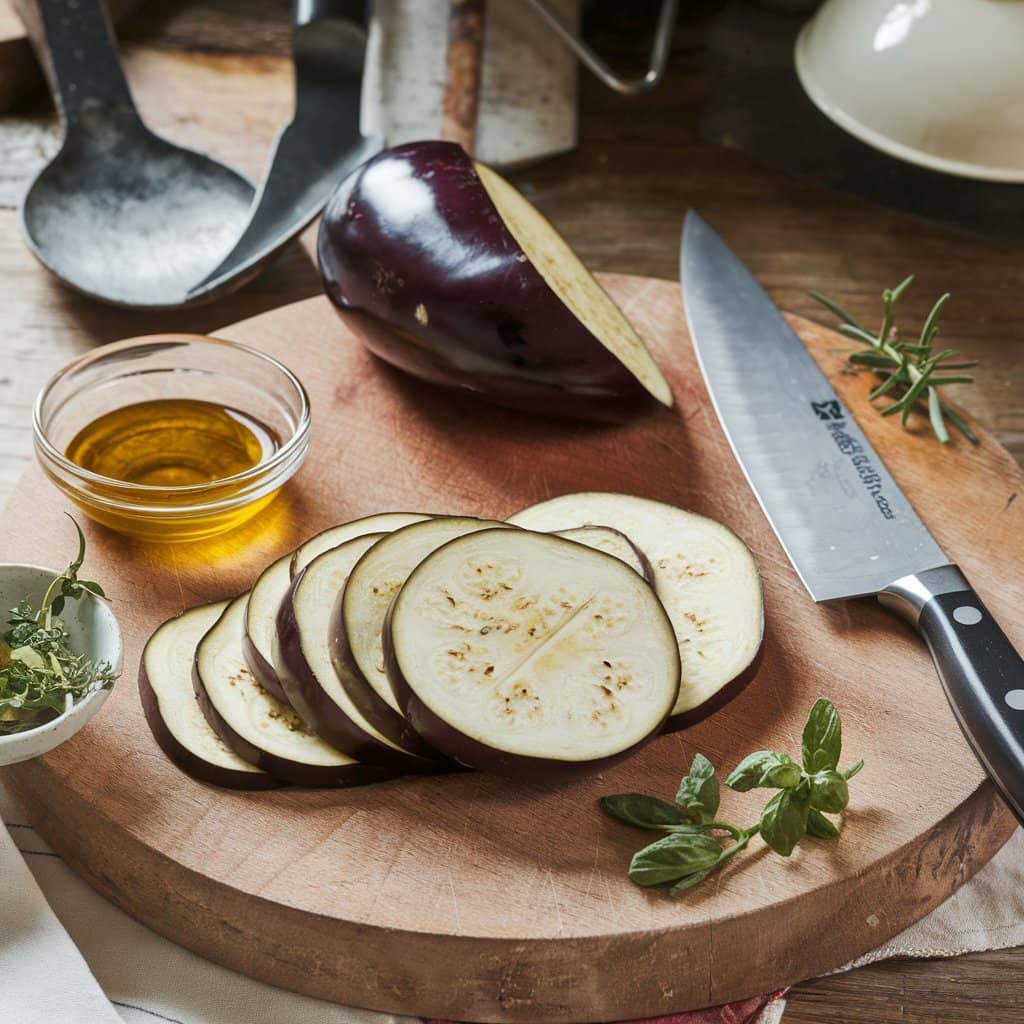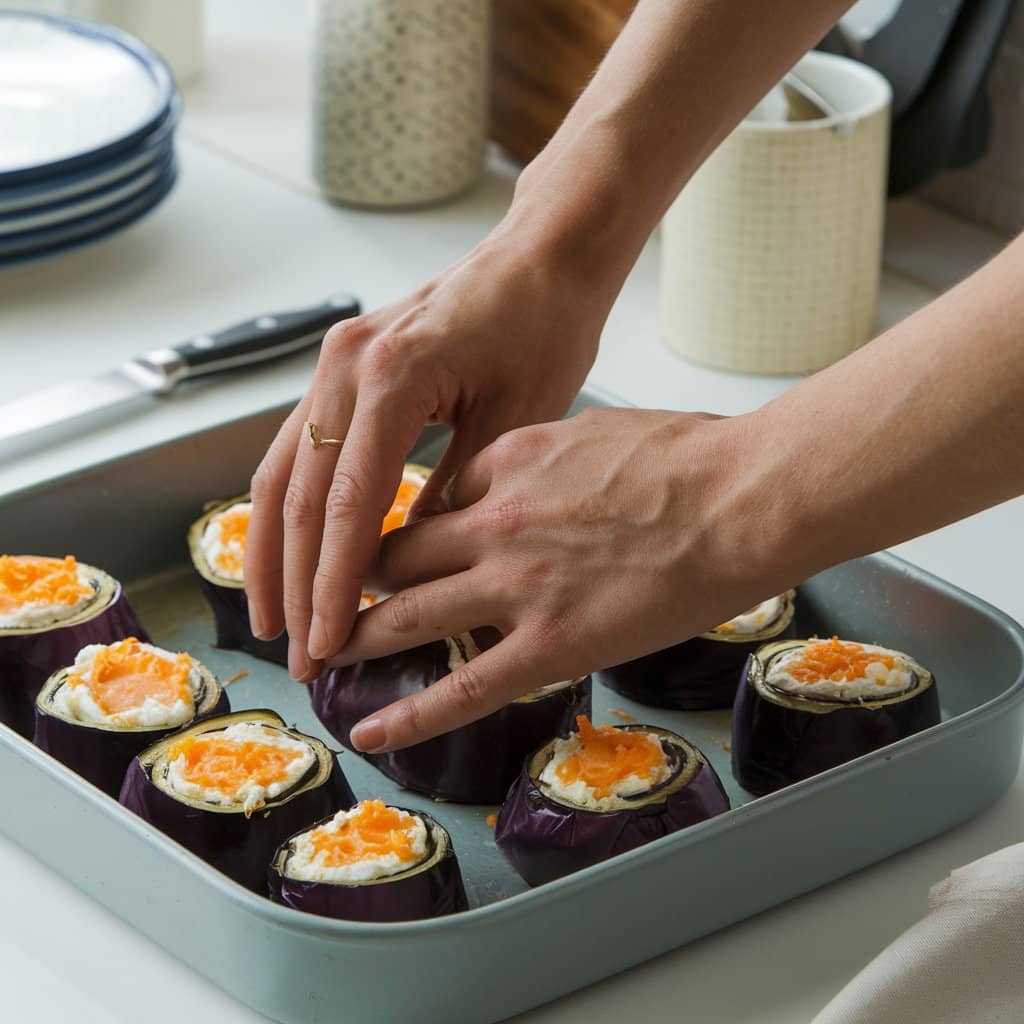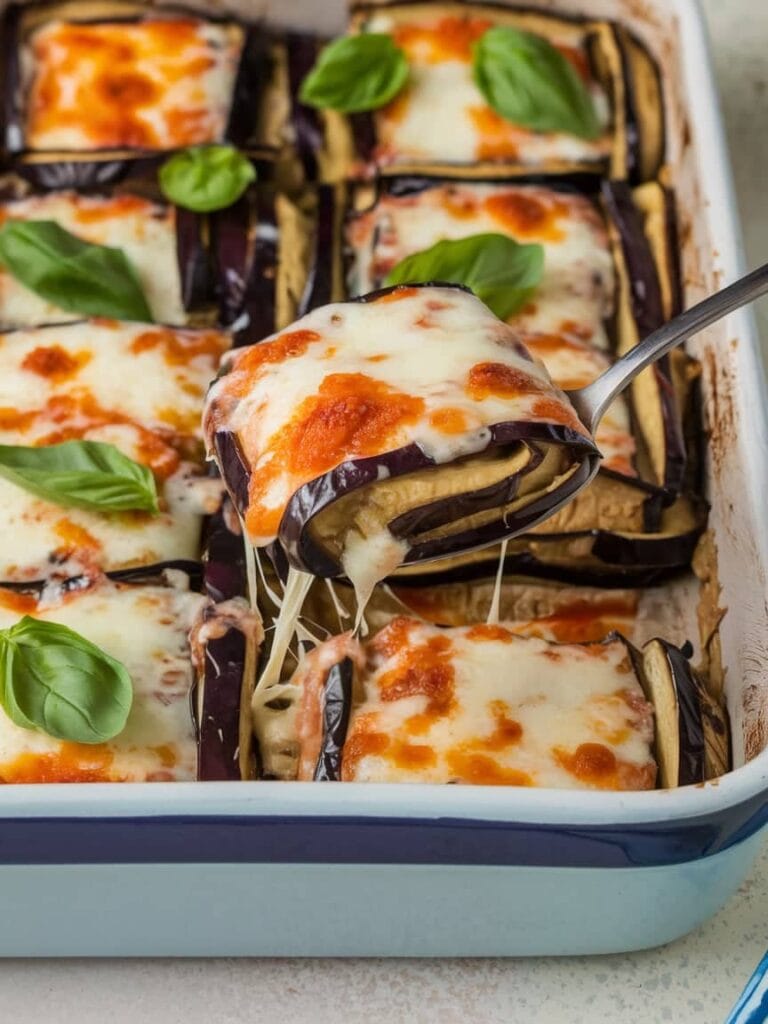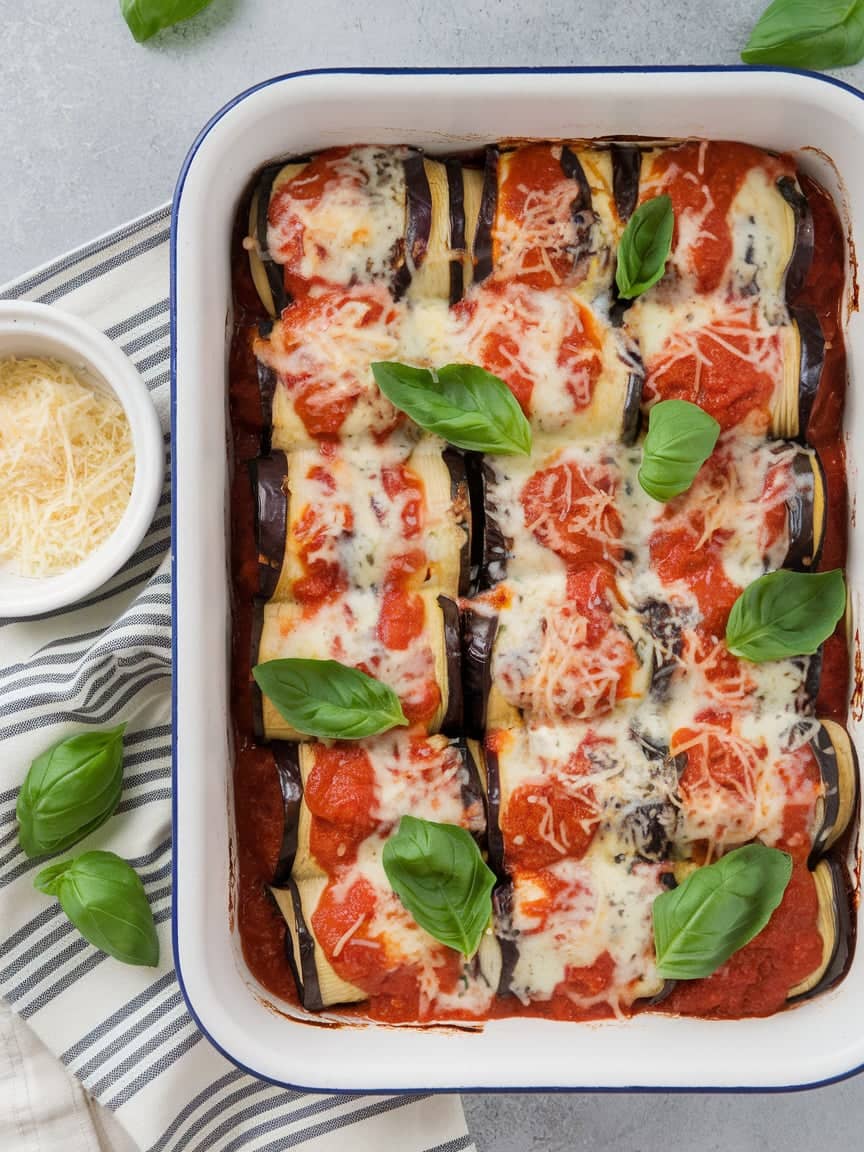Italian Eggplant Rollatini is a beloved Mediterranean dish known for its rich flavors, comforting texture, and irresistible aroma. This classic Italian recipe features thinly sliced eggplants rolled around a creamy ricotta and mozzarella filling, then baked in a savory tomato sauce. It’s a perfect blend of hearty, healthy, and flavorful ingredients that makes for a satisfying meal.
Eggplant Rollatini has become a staple in Italian-American cuisine, celebrated for its versatility and ease of preparation. Whether you’re a home cook looking for a cozy dinner option or a food enthusiast eager to explore Italian culinary traditions, this dish promises to deliver a mouthwatering experience.
Table of contents
History and Origins
Italian Roots and Traditional Variations
Eggplant Rollatini traces its origins back to Italy, where eggplants have been a key ingredient in Mediterranean cuisine for centuries. Though exact historical records are scarce, the dish likely evolved from “Involtini di Melanzane,” an Italian term meaning “rolled eggplants.” This dish became popular in Southern Italy, particularly in regions like Sicily and Naples, known for their fertile lands and rich culinary heritage.
Eggplants were introduced to Italy by Middle Eastern traders during the Middle Ages. Initially, eggplants were met with suspicion due to their bitterness. Over time, Italians developed cooking techniques like salting and frying to reduce the bitterness, giving rise to many iconic dishes like Eggplant Parmigiana and Eggplant Rollatini.
Traditional Recipe Elements
Traditional Eggplant Rollatini features:
- Eggplants: Thinly sliced and lightly fried or grilled.
- Filling: A blend of ricotta cheese, mozzarella, Parmesan, garlic, and fresh herbs like basil and parsley.
- Sauce: A robust tomato-based sauce made with crushed tomatoes, onions, garlic, and olive oil.
- Baking Method: The rolls are assembled, topped with more sauce and cheese, and baked to perfection.
Global Popularity
As Italian immigrants settled in North America, Eggplant Rollatini gained popularity in Italian-American restaurants. Today, it’s featured in Italian eateries worldwide, often served as an appetizer or a main course. Its comforting, cheesy layers and rich tomato flavors have made it a timeless favorite.
Ingredients and Preparation
Key Ingredients for Eggplant Rollatini
To create authentic Italian Eggplant Rollatini, choosing the right ingredients is essential. Here’s a breakdown of the core components that make this dish flavorful and satisfying:

1. Eggplants
- Type: Use medium-sized, firm, and shiny eggplants with smooth skin.
- Why: Smaller eggplants have fewer seeds, resulting in less bitterness.
2. Cheeses
- Ricotta Cheese: For a creamy filling. Use whole-milk ricotta for the best flavor.
- Mozzarella Cheese: Shredded for extra gooeyness on top.
- Parmesan Cheese: Adds a nutty, savory depth.
3. Tomato Sauce
- Crushed Tomatoes: Use San Marzano tomatoes for authentic Italian taste.
- Tomato Paste: For added richness and depth.
- Onions & Garlic: Sautéed for a flavorful base.
4. Herbs and Seasonings
- Fresh Basil & Parsley: Chopped for added freshness.
- Italian Seasoning: A mix of oregano, thyme, and rosemary.
- Salt & Pepper: To enhance the dish’s natural flavors.
5. Olive Oil
- Type: Extra virgin olive oil for frying and sauce preparation.
Choosing the Best Eggplants
How to Pick Fresh Eggplants:
- Look for smooth, shiny skin without bruises or soft spots.
- Choose eggplants that feel firm and heavy for their size.
- The stem should be green and fresh-looking.
Preparation Tips:
- Slice Evenly: Cut lengthwise into ¼-inch slices.
- Salt the Eggplant: Sprinkle with salt and let sit for 30 minutes to draw out bitterness and moisture. Pat dry before cooking.
How to Make Italian Eggplant Rollatini
Creating delicious Eggplant Rollatini at home involves several simple steps. Here’s a detailed guide to making this classic Italian dish from start to finish.

1– Prepare the Eggplants
- Slice the Eggplants:
- Cut the eggplants lengthwise into ¼-inch slices. Aim for even thickness for uniform cooking.
- Salt the Slices:
- Lay the slices on paper towels, sprinkle them with salt, and let them rest for 30 minutes. This process removes excess moisture and reduces bitterness.
- Rinse the eggplants and pat them dry.
- Cook the Eggplants:
- Option 1: Frying
- Heat olive oil in a large skillet over medium heat.
- Fry the eggplant slices until golden brown on both sides.
- Place them on paper towels to absorb excess oil.
- Option 2: Grilling or Baking
- Brush slices lightly with olive oil.
- Grill on a preheated grill or bake at 400°F (200°C) for 15-20 minutes until tender.
- Option 1: Frying
2– Make the Filling
- Combine the Ingredients:
- In a mixing bowl, combine:
- 2 cups ricotta cheese
- 1 cup shredded mozzarella cheese
- ½ cup grated Parmesan cheese
- 1 egg (for binding)
- 2 cloves garlic, minced
- 2 tablespoons chopped parsley
- 2 tablespoons chopped basil
- Salt and pepper to taste
- In a mixing bowl, combine:
- Mix Until Creamy:
- Stir the ingredients until smooth and well-blended. Adjust seasoning as needed.
3– Prepare the Tomato Sauce
- Sauté Aromatics:
- Heat olive oil in a saucepan over medium heat.
- Add 1 finely chopped onion and 3 minced garlic cloves. Sauté until softened.
- Cook the Sauce:
- Stir in:
- 2 cans of crushed tomatoes (28 oz each)
- 2 tablespoons tomato paste
- 1 teaspoon dried oregano
- Salt and pepper to taste
- Simmer for 20-25 minutes, stirring occasionally. Add fresh basil at the end.
- Stir in:

4- Assemble the Rollatini
- Preheat the Oven:
- Set the oven to 375°F (190°C).
- Roll the Eggplants:
- Spread a thin layer of tomato sauce on the bottom of a baking dish.
- Take an eggplant slice, spoon 2-3 tablespoons of the cheese mixture onto one end, and roll it up gently.
- Place seam-side down in the baking dish.
- Add More Sauce and Cheese:
- Pour remaining tomato sauce over the rolls.
- Sprinkle with additional mozzarella and Parmesan cheese.
5- Bake and Serve
- Bake the Rollatini:
- Cover the dish with foil and bake for 30 minutes.
- Remove the foil and bake for another 10-15 minutes until bubbly and golden brown.
- Serve Hot:
- Garnish with fresh basil or parsley.
- Serve with crusty Italian bread or a fresh green salad.
Serving Suggestions for Italian Eggplant Rollatini
Eggplant Rollatini is a versatile dish that pairs well with a variety of sides, beverages, and accompaniments. Here are some creative ways to serve this Italian favorite for maximum enjoyment.

1. Side Dishes
a. Fresh Salads
- Classic Caesar Salad: Crisp romaine, creamy Caesar dressing, and Parmesan shavings create a refreshing balance.
- Arugula and Cherry Tomato Salad: Toss with balsamic vinaigrette for a peppery, tangy contrast.
- Mediterranean Salad: Cucumbers, olives, and feta cheese offer a Mediterranean-inspired complement.
b. Starches
- Garlic Bread: Warm, crusty garlic bread makes a perfect side for soaking up the tomato sauce.
- Buttery Mashed Potatoes: A creamy and comforting addition.
- Herbed Rice Pilaf: Lightly seasoned rice balances the richness of the dish.
2. Wine Pairings
a. Red Wines:
- Chianti: A classic Italian red with bright acidity that cuts through the creamy cheese and tomato sauce.
- Montepulciano d’Abruzzo: A medium-bodied wine with fruity notes that complements the dish’s savory flavors.
- Sangiovese: Known for its rich red fruit flavors and earthy undertones.
b. White Wines:
- Pinot Grigio: Crisp and light, ideal for balancing the dish’s richness.
- Sauvignon Blanc: Its citrus and herbaceous notes add a refreshing contrast.
3. Presentation Tips
a. Plating the Rollatini:
- Serve 2-3 rolls per plate, topped with extra tomato sauce and a sprinkle of freshly grated Parmesan.
- Garnish with a basil leaf for a touch of freshness and visual appeal.
b. Elegant Serving Ideas:
- Family-Style: Serve in a large baking dish straight from the oven.
- Individual Servings: Use small ramekins for personalized portions.
- Appetizer Option: Slice each rollatini into bite-sized pieces and secure with toothpicks for party-friendly servings.
4. Special Occasions and Menus
- Weeknight Dinner: Pair with a simple green salad for a quick, satisfying meal.
- Holiday Feast: Serve as a vegetarian main course alongside a holiday spread.
- Dinner Party: Elevate with a multi-course Italian-themed menu, including antipasto, pasta, and dessert like tiramisu.
Nutritional Benefits of Eggplant Rollatini
Eggplant Rollatini is not only delicious but also packed with essential nutrients. Its combination of vegetables, cheeses, and herbs provides a balanced mix of vitamins, minerals, and proteins. Here’s a closer look at the nutritional value of this Italian favorite.
1. Key Nutrients in Eggplant Rollatini
a. Eggplants
- Low in Calories: Eggplants are naturally low in calories, making the dish lighter.
- High in Fiber: They promote healthy digestion and help regulate blood sugar.
- Rich in Antioxidants: Eggplants contain nasunin, an antioxidant that protects cells from damage.
- Source of Vitamins and Minerals: They provide vitamins C, K, B6, and minerals like potassium and magnesium.
b. Cheeses (Ricotta, Mozzarella, Parmesan)
- Protein-Rich: These cheeses supply high-quality protein essential for muscle development.
- Calcium and Phosphorus: Important for strong bones and teeth.
- Vitamin B12 and Zinc: Boost energy production and immune system health.
c. Tomato Sauce
- Rich in Lycopene: A powerful antioxidant that supports heart health and reduces inflammation.
- Vitamin C and Potassium: Help maintain a healthy immune system and fluid balance.
d. Olive Oil
- Heart-Healthy Fats: Extra virgin olive oil contains monounsaturated fats that support cardiovascular health.
- Anti-Inflammatory Compounds: Its polyphenols reduce inflammation and oxidative stress.
2. Health Benefits
a. Supports Heart Health
- The combination of eggplants, olive oil, and tomatoes contributes to a heart-healthy Mediterranean diet.
b. Aids Weight Management
- With its low calorie and high fiber content, Eggplant Rollatini can fit into a balanced weight-loss plan when prepared using healthier methods like baking or grilling.
c. Boosts Immunity
- The vitamins A, C, and E in the vegetables and herbs strengthen the immune system.
d. Promotes Healthy Digestion
- The fiber from eggplants and tomato sauce helps maintain gut health and prevent constipation.
3. Making a Healthier Version
If you’re looking to boost the nutritional profile of Eggplant Rollatini, consider these healthier adjustments:
- Bake Instead of Frying: Reduces added fat and calories.
- Use Low-Fat Cheeses: Substitute part-skim ricotta and mozzarella.
- Add More Vegetables: Include spinach, kale, or zucchini in the filling for extra nutrients.
- Limit Salt: Use herbs and spices for flavor instead of extra salt.
4. Special Diet Adaptations
- Vegetarian-Friendly: The dish is naturally vegetarian, providing ample protein from the cheeses.
- Gluten-Free: Use gluten-free breadcrumbs if needed.
- Low-Carb: It’s already a low-carb option when eggplants replace pasta.
- Keto-Friendly: Modify the recipe by using full-fat cheeses and skipping any added sugar in the tomato sauce.
Popular Variations of Eggplant Rollatini
Eggplant Rollatini is a versatile dish that can be adapted to fit various dietary preferences and flavor profiles. Whether you’re looking for a vegetarian twist, a vegan alternative, or something gluten-free, these popular variations will inspire your next culinary creation.

1. Vegetarian Variations
a. Spinach and Ricotta Rollatini
- What’s Different: Add sautéed spinach to the cheese filling.
- Why Try It: Boosts fiber, vitamins, and adds a fresh, earthy flavor.
b. Mushroom and Cheese Rollatini
- What’s Different: Add finely chopped mushrooms to the filling.
- Why Try It: Mushrooms add a meaty texture and a savory, umami-rich taste.
c. Mediterranean-Style Rollatini
- What’s Different: Add ingredients like olives, sun-dried tomatoes, and feta cheese.
- Why Try It: This version brings bold Mediterranean flavors to the dish.
2. Vegan Eggplant Rollatini
a. Dairy-Free Cheese Filling
- Cheese Substitutes: Use cashew-based ricotta or tofu blended with nutritional yeast, lemon juice, and garlic.
- Sauce Tips: Ensure the tomato sauce is free of added dairy.
b. Plant-Based Protein Additions
- Add crumbled tempeh or lentils for added protein and heartiness.
c. Nut-Free Option
- Use store-bought vegan cheeses labeled nut-free if needed.
3. Gluten-Free Eggplant Rollatini
a. Skip the Breadcrumbs
- Why It Works: Eggplant Rollatini doesn’t require breadcrumbs unless desired for added crunch on top.
b. Use Gluten-Free Flour
- Lightly coat eggplant slices in gluten-free flour before baking or grilling for extra texture.
c. Gluten-Free Pasta Rollatini
- Replace eggplant with gluten-free lasagna noodles if you prefer a pasta-based version.
4. Low-Carb & Keto-Friendly Rollatini
a. Full-Fat Cheeses
- Use full-fat ricotta, mozzarella, and Parmesan for maximum flavor and keto compatibility.
b. Extra Protein Filling
- Add cooked Italian sausage, ground turkey, or beef to the filling.
c. Zucchini Rollatini
- Substitute eggplant with thinly sliced zucchini for a similar low-carb experience.
5. International Flavor Twists
a. Mexican-Style Rollatini
- Filling: Use spiced black beans, corn, and cheddar cheese.
- Sauce: Swap tomato sauce for enchilada sauce.
b. Greek-Inspired Rollatini
- Filling: Combine feta, spinach, and Kalamata olives.
- Sauce: Use a tomato and red pepper-based sauce for added depth.
c. Middle Eastern Rollatini
- Filling: Use spiced chickpeas and tahini sauce for a bold flavor upgrade.
Tips for Perfect Eggplant Rollatini
Making Eggplant Rollatini can be simple, but a few expert tips will elevate your dish from good to great. Follow these essential techniques to ensure perfectly cooked eggplants, a flavorful filling, and a beautifully presented meal.
1. Preparing the Eggplants
a. Choose the Right Eggplants
- Use small to medium-sized eggplants for fewer seeds and less bitterness.
- Look for firm, shiny, and smooth-skinned eggplants without bruises or blemishes.
b. Slice Evenly
- Cut the eggplants lengthwise into ¼-inch slices for uniform cooking and easier rolling.
c. Remove Bitterness
- Salt the Slices: Sprinkle both sides of the slices with salt and let them sit for 30-45 minutes to draw out moisture and bitterness.
- Rinse and Dry: Rinse the slices under cold water and pat them dry with paper towels.
2. Cooking the Eggplants
a. Baking Method (Healthier Option)
- Brush Lightly with Olive Oil: Use a brush to apply a thin coat of olive oil.
- Bake: Arrange slices on a baking sheet and bake at 400°F (200°C) for 15-20 minutes, flipping halfway through.
b. Grilling Method (Smoky Flavor)
- Preheat a grill to medium-high.
- Grill eggplant slices for 2-3 minutes per side until softened and slightly charred.
c. Frying Method (Traditional Method)
- Heat olive oil in a skillet over medium heat.
- Fry slices in batches for 2-3 minutes per side until golden brown.
- Drain on paper towels to remove excess oil.
3. Perfecting the Filling
a. Use Fresh Cheeses
- Ricotta Cheese: Use whole-milk ricotta for maximum creaminess. Drain excess liquid if the ricotta is too watery.
- Mozzarella & Parmesan: Shred your own cheeses for better melting and richer flavor.
b. Enhance with Herbs and Spices
- Add freshly chopped basil, parsley, and a pinch of nutmeg to the filling for extra depth.
- Use garlic powder, onion powder, and Italian seasoning for a more robust taste.
4. Assembling the Rollatini
a. Use Enough Filling
- Spread about 2-3 tablespoons of the cheese mixture onto each eggplant slice. Avoid overstuffing to prevent the rolls from bursting.
b. Roll Gently
- Start rolling from the narrower end of the eggplant slice for a tighter, more secure roll.
c. Arrange Neatly
- Place rolls seam-side down in the baking dish to keep them intact while baking.
5. Making the Sauce
a. Use High-Quality Tomatoes
- Use San Marzano tomatoes or other premium canned tomatoes for the best sauce flavor.
b. Simmer for Depth
- Simmer the sauce for at least 20-30 minutes to develop a rich, savory taste.
c. Balance the Flavors
- Add a pinch of sugar if the tomato sauce is too acidic. Adjust salt, pepper, and herbs as needed.
6. Baking for Perfection
a. Cover First
- Cover the dish with foil for the first 30 minutes of baking to lock in moisture.
b. Finish Uncovered
- Remove the foil and bake for another 10-15 minutes until bubbly and golden brown.
7. Presentation and Garnishing
a. Add Finishing Touches
- Sprinkle fresh basil, parsley, or grated Parmesan over the finished dish before serving.
b. Serve Hot
- Allow the Rollatini to rest for 5-10 minutes after baking to make serving easier and avoid burning the mouth.
Common Mistakes to Avoid
- Skipping the Salting Step: Leads to watery, bitter eggplants.
- Using Watery Ricotta: Drain ricotta beforehand for a firmer filling.
- Overloading the Filling: Use a modest amount to keep rolls intact.
- Undercooking the Sauce: Ensure a long simmer for richer flavors.
Frequently Asked Questions (FAQs)
Here are answers to common questions about preparing, serving, and storing Eggplant Rollatini.
1. Can Italian Eggplant Rollatini Be Made Ahead of Time?
Yes. You can assemble Eggplant Rollatini up to 24 hours in advance. Store it covered in the refrigerator, and bake it when ready to serve. Add 10-15 minutes to the baking time if baking directly from the fridge.
2. Can I Freeze Eggplant Rollatini?
Yes. Follow these steps for freezing:
- Before Baking: Assemble the dish but do not bake it. Wrap it tightly with plastic wrap and aluminum foil. Freeze for up to 3 months.
- After Baking: Let it cool completely, then freeze in individual portions. Reheat in the oven at 375°F (190°C) until heated through.
3. How Do I Reheat Leftover Italian Eggplant Rollatini?
- Oven: Preheat to 350°F (175°C). Cover the dish with foil and bake for 20-25 minutes until heated through.
- Microwave: Use a microwave-safe dish, cover loosely, and heat on medium power for 3-5 minutes, checking periodically.
4. How Do I Keep the Eggplant from Becoming Soggy?
- Salt the Eggplant: Always salt the eggplant slices and let them sit for 30-45 minutes to remove excess moisture.
- Use the Right Cooking Method: Baking or grilling the eggplant before assembling keeps it firmer. Avoid overloading the rolls with sauce.
5. What Can I Use Instead of Ricotta Cheese?
- Cottage Cheese: Blend until smooth for a similar texture.
- Mascarpone or Goat Cheese: For a richer, creamier filling.
- Vegan Options: Use cashew ricotta or tofu blended with nutritional yeast and herbs.
6. What Should I Serve with Italian Eggplant Rollatini?
- Salads: Caesar salad or a mixed greens salad.
- Side Dishes: Garlic bread, roasted vegetables, or herbed rice.
- Wine Pairing: Try a glass of Chianti, Pinot Grigio, or Sauvignon Blanc.
7. Can I Make It Vegan or Gluten-Free?
- Vegan: Substitute dairy cheeses with plant-based options like cashew ricotta, almond mozzarella, or vegan Parmesan.
- Gluten-Free: Skip breadcrumbs or use gluten-free flour for coating the eggplant if frying.
8. How Many Calories Are in Italian Eggplant Rollatini?
The calorie count depends on the recipe and portion size. A standard serving of Eggplant Rollatini contains approximately 300-400 calories, depending on ingredients like cheese, oil, and sauce.
9. Can I Use Zucchini Instead of Eggplant?
Yes. Thinly sliced zucchini can replace eggplant for a lighter, low-carb version. Follow the same preparation and cooking steps.
10. Is Italian Eggplant Rollatini the Same as Eggplant Parmesan?
No. While both dishes use eggplant, Eggplant Rollatini features rolled eggplant slices filled with cheese and baked in tomato sauce. Eggplant Parmesan involves breaded eggplant slices layered with sauce and cheese, similar to a lasagna.
Conclusion : Italian Eggplant Rollatini
Italian Eggplant Rollatini is a timeless Italian classic that blends savory tomato sauce, creamy cheeses, and tender eggplant into a satisfying and flavorful dish. Its rich history, Mediterranean roots, and versatility make it a favorite in kitchens worldwide. Whether you’re preparing a traditional recipe or experimenting with vegan, gluten-free, or low-carb variations, Eggplant Rollatini offers endless possibilities for customization.
By following expert tips on selecting, preparing, and assembling ingredients, you can create a restaurant-quality dish right at home. Pair it with a fresh salad, crusty garlic bread, and a glass of fine wine for a complete Italian dining experience.
With its nutritional benefits and comforting flavors, Eggplant Rollatini is perfect for weeknight dinners, special occasions, or holiday feasts. Try this beloved recipe and experience the best of Italian cuisine with every delicious bite.

